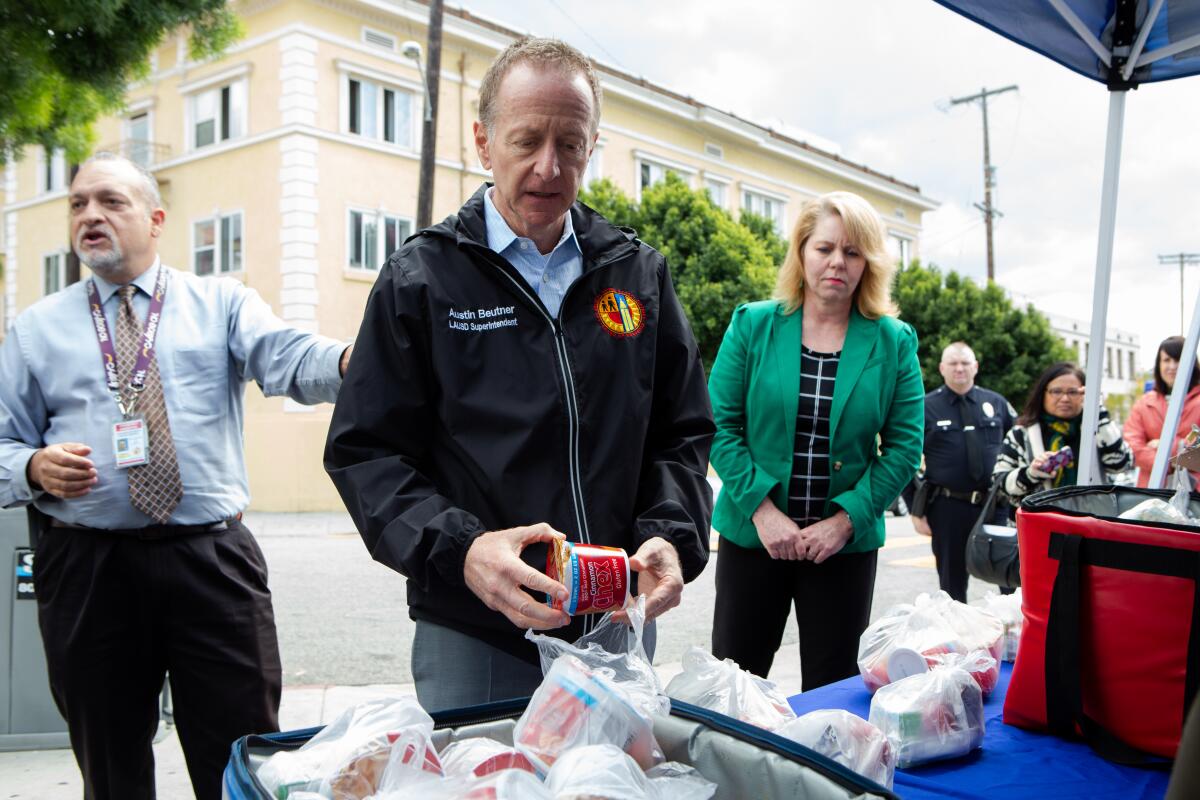Editorial: Austin Beutner: His lasting legacy was feeding Los Angeles’ kids

- Share via
Austin Beutner took the helm of the Los Angeles schools in May 2018 more quietly than many of his predecessors. He was well aware that he wasn’t a hugely popular choice as an executive rather than as an educator. He leaves office today, also quietly, having met the moment of a historic pandemic.
COVID-19 changed everything, and it needs to factor into any assessment of Beutner’s tenure. Nearly half of his three-year term has been preoccupied with the pandemic. Few obligations take precedence over giving a child a strong educational start — but one of those obligations is making sure those kids are fed. It is to his lasting credit that the school district provided millions of meals, a crucial lifeline to some of the most vulnerable families. Many of those families were Black or Latino, led by parents juggling essential work on the front lines — if they had been lucky enough to keep their jobs at all.
The job of school superintendent is notoriously difficult anywhere but perhaps nowhere more so than Los Angeles, the country’s second-largest district, responsible for 500,000 students, 80% living in poverty and around 16% with special learning needs. Past superintendents in Los Angeles included a governor of Colorado and a retired Navy vice admiral; for decades, the job has oscillated between insiders and outsiders.
Beutner’s predecessor, Michelle King, who had come up through the ranks to become the district’s first Black female chief executive, led the district for only about half her contract before being forced to take a long-term medical leave by a cancer that took her life in early 2019.
She was seen as a calming influence after a series of short-term superintendents, including the disruptor John Deasy, who was known for his sometimes disrespectful attitude toward teachers and the disastrous iPads-for-all initiative. Deasy resigned under a cloud, his iPad venture dead; King settled the waters but didn’t have enough time to accomplish much. It was Roy Romer, the former governor who led the district from 2000 to 2006, who had made the most difference in recent decades, overseeing a massive school-building effort that was the largest public construction project in the nation and straightening out an impossibly arcane teacher-hiring system.
Beutner, a former investment banker, deputy mayor and publisher of the Los Angeles Times, was seen as a leader who could get things done without putting the district into a continual uproar. He stumbled early on but found firmer footing along the way. His efforts were focused rather than sweeping, but ultimately might end up being more lasting than those of his nearest predecessors.
His relationship with the teachers union, United Teachers Los Angeles, started out rough. The union had viewed his appointment with suspicion, portraying him as a tool of pro-charter-school forces and wealthy critics of the school district. It didn’t help when Ref Rodriguez, who had provided crucial support in the school board’s 4-3 early vote to move Beutner’s hiring forward, resigned a few weeks later and pleaded guilty to corruption charges. Nor did Beutner endear himself to the union when his plans to decentralize the school district were not prepared with an eye toward transparency.
Months into his tenure, Beutner and UTLA clashed over union demands and predictions that the district was heading toward a financial cliff. The six-day teachers’ strike in January 2019, part of a newfound militancy among teachers unions nationwide, remains hard to fully comprehend. The district had already offered teachers a substantial raise, and in the end, they settled for that amount (6% over two years), while losing pay for the six days they were out. The strike became a rallying cry for the kinds of changes that were sure to garner parent and student support, such as smaller class sizes and a nurse at every school. But the reduction in class size was barely perceptible, and the nurses simply weren’t available for hire. The statewide nursing shortage means they still aren’t, though the district, now more flush with money because of a robust state budget and federal rescue funds, has held to the goal.
That’s why the strike seemed more a flexing of power than a basic labor dispute, one designed to weaken the superintendent. Our advice to Beutner when he was hired was to reach out to teachers, advice we wish he had taken up sooner.
Beutner took on a more union-conciliatory approach after the strike. He looked for common ground and can take credit for reducing chronic student absenteeism rates, which not only impeded learning and but also cost the school district considerably, since it lost per-pupil funding from the state with each absence.
The superintendent also led the most successful lobbying effort in recent memory by the district, getting the state to cough up needed money for educating students with disabilities.
But greater collaboration with UTLA also led to a serious miscalculation, when Beutner set aside his previously cautious approach to asking the public to tax itself for the schools and pushed the school board to place a parcel tax, Measure EE, on the ballot in June 2019, a low-turnout election. The thinking was that the public had shown such great support for the striking teachers, and appeared in polls to favor a tax, that the district could ride that wave to the two-thirds approval the measure needed. It proved a major tactical error. The proposed tax failed to garner even a simple majority, as voters in lower-income areas didn’t turn out in large numbers for an off-year election.
His two most recent achievements, though much smaller in scope, also were the kinds of developments that anyone would cheer: private funding from big-name celebrities — Dr. Dre, Jimmy Iovine, George Clooney — for yet-to-be-opened magnet schools that should prove highly popular with students. Previously, private money tended to go to charter schools, which are independently operated, not to magnets, which are run by the district. The new magnet schools will keep enrollment — and the state funding it brings — within the district.
It would have been good to see more movement on the instruction and curriculum front, but Beutner deserves credit for the Primary Promise program, which is ramping up from the initial 2,500 students in kindergarten through third grade to 7,000 this fall, with hopes for additional expansion. The program uses specially trained instructors to provide additional instructional time for children who are not up to grade level in reading, identifying and then focusing on the areas that stymie students. Results with the earliest students were remarkable. This fall, math will be added to the program because half the district’s students flunk algebra on their first try. Often, the problem isn’t their understanding of algebra skills but a lack of foundational math skills such as multiplication.
It’s the response to the pandemic, however, for which Beutner will be remembered best. And as a systems person with outstanding organization skills, he notched some major accomplishments. He moved more quickly and aggressively than other big-district superintendents, such as those in New York or Chicago, to get computers into the hands of students who lacked them and provide broadband as well so that students could learn remotely. The system didn’t always work perfectly; connections would slow as siblings shared devices or bandwidth, or the video would freeze up. But it would have been hard to make this work perfectly even under the best of circumstances for hundreds of thousands of students.
Beutner also had filtration systems at schools replaced quickly with top-of-the-line models, and worked out a unique agreement for expansive COVID-19 testing of students and staff that would provide results before school opened the next day, minimizing the chances of spread.
Most notable was the leading role the school district played in shoring up the safety net for students, their families and even the community at large. Toys and other items joined the giveaways. This effort reduced or prevented hunger and stress for families when parents couldn’t work or faced other pandemic-related financial issues.
At the same time, L.A. Unified didn’t negotiate the kind of agreement with teachers during the strike that other large districts in California managed, leaving students with less face-to-face instructional time. And Beutner gave in to the demands of the union in the belief that schools should not open before teachers were vaccinated, even though the head of the Centers for Disease Control and Prevention said in early February that schools could reopen safely without those vaccines.
Should the state have demanded that public schools open at the point where it was deemed safe? Of course. But districts also needed to stand firm on the importance of returning students to the classroom as soon as possible.
And when L.A. Unified schools did reopen, the “Zoom in a room” model used at the high schools — with students still learning remotely, but sitting in classrooms — lacked appeal for many parents and students, justifiably so. Better planning and earlier outreach could have lessened a conflict that ended up being portrayed as whiter, wealthier families eager to reopen schools pitted against Black and Latino working-class families who had borne the brunt of the pandemic and whose top priority was absolute safety. Other districts managed it, and L.A. Unified could have as well.
Of course, Beutner was limited in what he could do without full support of the board. When he pushed for a longer school year to increase instructional time — and a union full of remote-instruction-weary teachers pushed back — Beutner was unable to summon the board to his side. That’s a shame. It could have made a real difference, and some changes to the schedule could have made it more palatable to understandably burned-out teachers.
These were strange times, to put it mildly. Beutner’s successes can’t be measured by whether test scores or graduation rates rose, not with a killer disease closing campuses. Feeding and equipping students was more important than whether they got a little extra instructional time. Beutner put his priorities in the right place; it was the moment to be more than an education official, and he stepped up admirably.
By the time the crisis was over, though, the ideological makeup on the board had changed again. There also had been some discontent from board members who resented seeing their media-savvy superintendent take the center stage during the pandemic.
That’s on them. No one was keeping the board from putting in the kind of double-shift effort that Beutner kept up throughout the crisis. There was talk about a short extension of Beutner’s contract — hardly a ringing endorsement. But Beutner, 61, has been through the wringer; though he has not said anything about his future plans, no one could blame him for not having them.
The pandemic is quelled and Beutner is off to a new chapter. There were significant stumbles but also significant work accomplished. Had the pandemic not occurred, L.A. Unified would probably have been making more progress with its students than it was before Beutner came on board. He focused his efforts on discrete, actionable areas — absenteeism, district financing (especially for special-needs students), and elementary-school instruction — that will have a chance to show their merit after he is gone. That’s not earth-shattering progress, but real improvement in education seldom is.
More to Read
A cure for the common opinion
Get thought-provoking perspectives with our weekly newsletter.
You may occasionally receive promotional content from the Los Angeles Times.










